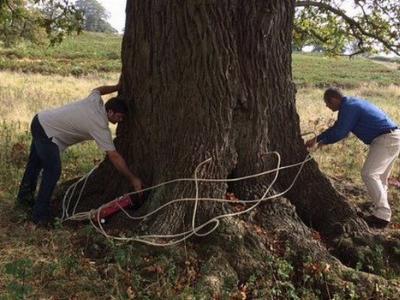Garlic injection could tackle tree diseases

Injecting trees with a concentrated form of garlic might help save trees in the UK from deadly diseases.
The treatment could potentially help save trees of historic or sentimental value
Operating under an experimental government licence, a prototype piece of technology to administer the solution is being trialled on a woodland estate in Northamptonshire.
Widespread use of the injection process is impractical and expensive.
But it could potentially help save trees of historic or sentimental value.
Garlic is one of nature's most powerful antibacterial and antifungal agents.
It contains a compound called allicin, which scientists are interested in harnessing.
The experimental injection device is made up of a pressurised chamber and eight "octopus" tubes.
The pressure punches the solution through the tubes and through special injection units in to the tree's sap system. The needles are positioned in a way to get allicin evenly around the tree.
The moment the active agent starts to encounter the disease, it destroys it. The poison is organic and isn't rejected by the tree.
It is pulled up the trunk out along the branches and in to the leaves by the process of transpiration - the flow of water through a plant.
Tree consultant Jonathan Cocking is involved with the development and deployment of the treatment.
"Over the last four years we have treated 60 trees suffering badly with bleeding canker of horse chestnut. All of the trees were cured.
This result has been broadly backed up by 350 trees we have treated all over the country where we have had a 95% success rate."
Oak trees with acute oak decline - which eventually kills the tree - have improved after being treated. In laboratory conditions allicin kills the pathogen chalara which is responsible for ash dieback.
The solution is made by a company in Wales. "Organic cloves of garlic are crushed," said Mr Cocking, "and a patented method is used to amplify the volume of allicin and improve the quality of it so it is stable for up to one year. Allicin in the natural world only lasts for about 5-10 minutes.
If you go back to the tree the day after, and crush a leaf that is in the extremity of the crown, you can often smell the garlic."
The goal is to get a commercial licence by the beginning of next year.
According to Prof Stephen Woodward, a tree expert at Aberdeen University: "The antibacterial properties of allicin are well-known in the laboratory. I have not heard of it being used in trees before, but yes this is interesting. It could work."
However Mr Woodward cautioned about such methods of "biological control". "Despite being plant-based that doesn't mean it can't harm an ecosystem. For example cyanide is plant-based."
Many conservationists also caution against such drastic intervention. Dr Anne Edwards from the John Innes Centre was one of the first to identify ash dieback in a coppice wood in Norfolk.
She said that this treatment would not be effective for ash dieback: "In a woodland setting we really have to let nature take its course. It's very depressing," she explained.
The Woodland Trust also favours a different approach. The organization is investing £1.5m in a seed bank. The idea is to grow trees that are fully traceable and therefore free from foreign disease.
Austin Brady, director of conservation and external affairs, said: "Our native woodland needs to build its resilience to disease and pests. By starting from the beginning of the supply chain we can ensure that millions of trees will have the best possible chance of survival in the long term."
In recognition of the threat posed by current and future tree and plant biosecurity, Defra recently appointed a Chief Plant Health Officer, and has earmarked £4 million for research in to treatments.
Có thể bạn quan tâm
Phần mềm

Phối trộn thức ăn chăn nuôi

Pha dung dịch thủy canh

Định mức cho tôm ăn

Phối trộn phân bón NPK

Xác định tỷ lệ tôm sống

Chuyển đổi đơn vị phân bón

Xác định công suất sục khí

Chuyển đổi đơn vị tôm

Tính diện tích nhà kính

Tính thể tích ao hồ



 Separate Hydrogen and Oxygen from water through electrolysis
Separate Hydrogen and Oxygen from water through electrolysis  HN diagnoses fish death causes
HN diagnoses fish death causes